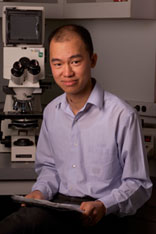 |
Our major research goal is to define and understand the
cellular and molecular pathways required for a successful immune response
against intracellular pathogens. This entails a balance between responses
that suppress the growth and survival of invading pathogens and those that
prevent destruction of host tissues. The murine model of Toxoplasma gondii
infection provides a useful tool for these studies. Host survival and
immunity to this ubiquitous and highly evolved parasite is mediated by the
cytokines interferon-gamma and tumor necrosis factor-alpha produced by T
lymphocytes activated during the course of infection. We are addressing two
basic questions: 1) What are the intracellular molecular mediators of
cytokine-induced protective responses? 2) How are the lymphocytes that
produce these protective cytokines generated and maintained?
Yap. G.S. and A. Sher. Cell-mediated immunity to
Toxoplasma gondii: Initiation, regulation and effector function. Immunobiology 201:240-247, 1999.
Yap. G.S. and A. Sher. Effector cells of both non-hemopoietic and
hemopoietic origin are required for interferon-gamma and tumor necrosis
factor-alpha dependent host resistance to Toxoplasma gondii. J. Exp. Med. 189:1083-1091, 1999.
|
